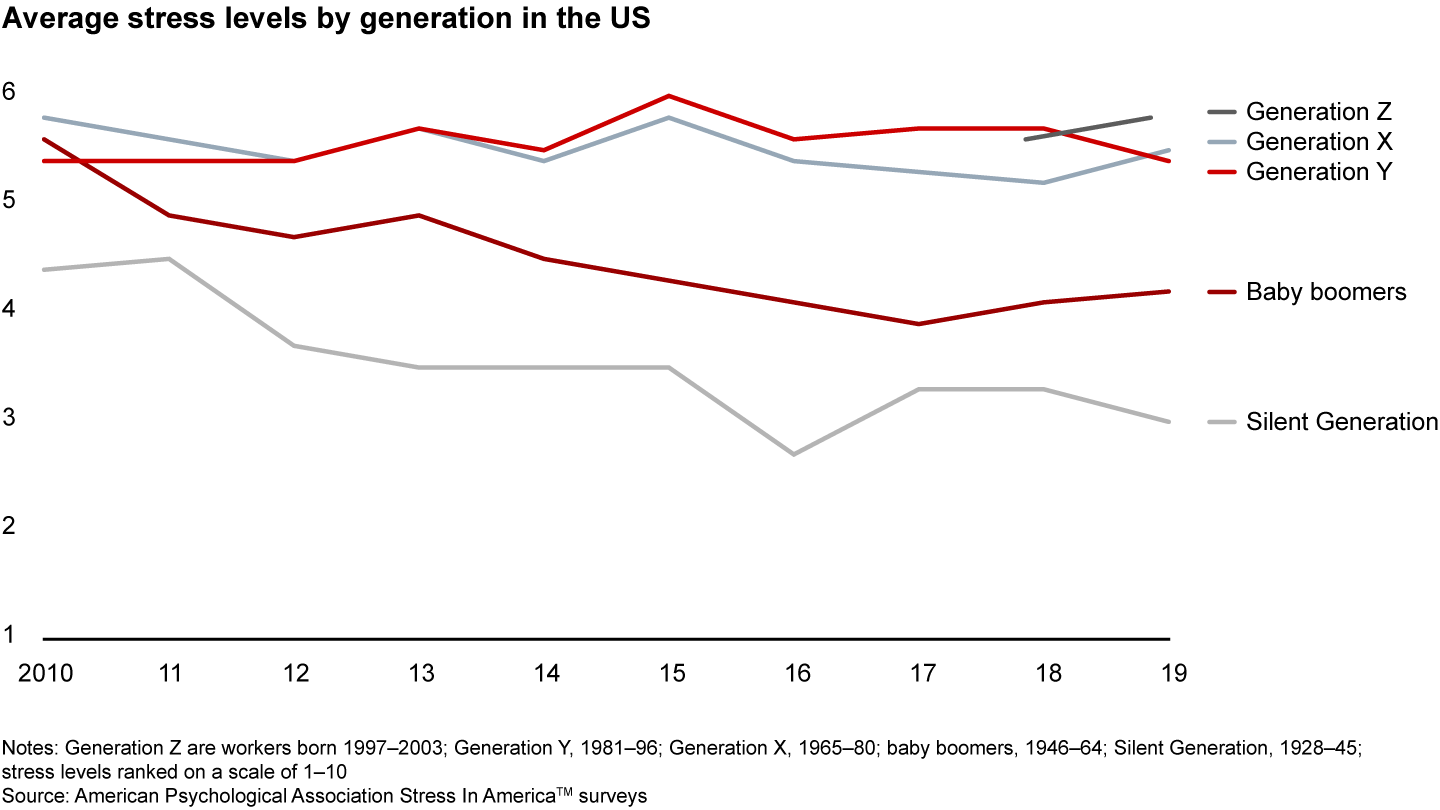
Not only has Covid-19 led to a tragic loss of life around the world, but it has also caused immense psychological strain. Individuals have coped with grief, adapted to social isolation, and reconfigured the way they work, all at the same time. The portion of American adults exhibiting signs of an anxiety disorder leaped from 8% in 2019 to a peak of 36% by December 2020. The pandemic has undoubtedly been an example of what sociologists call a “collective trauma” event.
However, stress levels have been rising for some time now, particularly for younger generations. Although longitudinal data over an extended time period is sparse, even in the last decade, the reported stress levels across generations has started to diverge. Generation X, Generation Y, also known as millennials, and Generation Z no longer experience the steady decline in stress that has historically been associated with aging (see Figure 5.1).


Unlike older cohorts, younger generations are grappling with a new mix of stressors. The combination of slowing economic growth, rising inequality, and declining housing affordability across the West has made it far more difficult for younger workers to attain financial stability. The dark sides of recent technological progress add to these challenges: Email blurs the lines between work and personal time, an issue only compounded by working from home. Social media pushes younger generations to constantly compare their lifestyles with those of their peers. And the acceleration of innovation cycles creates the illusion of life at twice the speed.
Younger workers have also been exposed to broader turbulence over the past decade, including greater political polarization, geopolitical tensions, and concerns about climate change, not to mention a pandemic. The lives of younger generations are characterized by a far higher degree of ambiguity and uncertainty—and they simply haven’t been educated on how to cope with it.
Of all these issues, the economic stressors matter most to young workers. When we asked workers across Western markets to share their biggest concerns for the next 5 to 10 years, 61% of respondents under 35 cited financial issues, job security, or failing to meet their career goals. Only 40% of those over 35 cited the same concerns.
of workers under 35 expressed concerns about financial issues, job security, or failure to meet career goals
of workers over 35 cited the same concerns
The odds of achieving absolute upward mobility—earning more than one’s parents—are the lowest they have been in the US for any generation since World War II. For the Silent Generation, about 90% of workers could expect to earn more than their parents, with the figure even higher for all but the wealthiest families. For Generation X, this figure had fallen to about 50%, with the biggest decline in the middle class. The emerging data for Generation Y suggests the picture is worsening. This trend is consistent across the West, with absolute upward mobility at levels equal to or below the lowest on record, which stretches back to the beginning of the 20th century.
Two factors have contributed to the decline in absolute upward mobility: slowing growth and rising inequality. The youngest generation of workers has seen inequality skyrocket, as the earnings gap between those who enter high-skill professions and those who do not continues to widen. The growing income premium for a college degree certainly plays a role in this story. But it’s now estimated that more than 40% of recent college graduates end up in jobs that don’t require higher education. Today’s labor markets are increasingly characterized by a winner-takes-all dynamic, where a small number of graduates capture a vast majority of the returns on education.
“The lives of younger generations are characterized by a far higher degree of ambiguity and uncertainty—and they simply haven’t been educated on how to cope with it.”
In places like the US, where higher education receives limited public funding, universities are also saddling workers with crippling debt. In Europe, younger workers are often spared the burden of student debt, but youth unemployment has reached crushing levels—37% in Spain, 29% in Italy, and 19% in France—as the fallout of the financial crisis more than a decade ago continues to limit opportunities.
On top of everything else, younger workers will grapple with the burden of caring for an aging population. They also face the challenge of paying down public debt, which has ballooned as a result of the pandemic, at a time of slowing macroeconomic growth.
The psychological effects of these pressures should not be underestimated. To see what could be in store for the West, one can look to Japan. In the 1990s, the term hikikomori was added to the lexicon to describe the growing phenomenon of young adults who had failed to secure jobs during Japan’s prolonged economic slowdown known as the Lost Decade. Their feelings of shame and defeat led them to withdraw from the labor market permanently and become recluses who lived with their parents well into their adult years. Since then, the number of hikikomori has steadily grown to more than a million people, according to government estimates.

Six Worker Archetypes for the World Ahead
There’s no such thing as the “average” worker. Understanding six archetypes can help firms build an effective talent strategy.
Given cultural differences, such a pattern may or may not emerge in the West. But it’s evident that many young people have become disillusioned with the prevailing economic system and mainstream politics. As a result, some have gravitated toward radical political movements. Others are seeking change through economic, rather than democratic, processes. This includes consuming and investing based on their individual beliefs, although the impact tends to be diffuse. Many young people sense that the best way to achieve change is by encouraging their employers to take more active stances on social and political issues. In some cases, these workers are willing to vote with their feet.
Looking at the emerging economies of the world, the youngest generations have had a very different experience. In countries like China, Indonesia, and Nigeria, younger workers are experiencing less instability than their predecessors, while economic liberalization and convergence are rapidly increasing their prospects for upward income mobility. According to our survey, 81% of workers in emerging markets said they felt optimistic that their lives would be better 5 to 10 years from now, compared with only 63% in developed economies. It may be too early to say how much these diverging experiences could reshape global competitiveness in the coming decade, but it does reinforce the point that the hopes and fears of workers in the developed and developing world are distinct.

About the Research
Data powered by Dynata, a leading global first-party data and insights platform.






